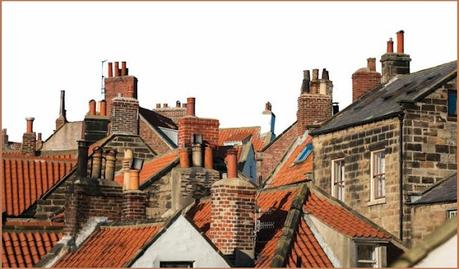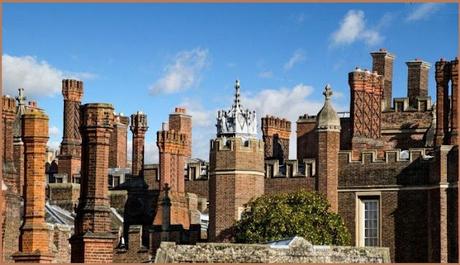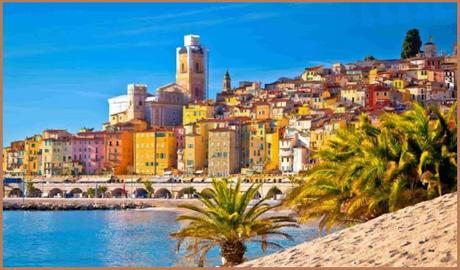By contrast, there's a paragraph in a Len Deighton novel set later in time in 1940s London that reads as follows: "The rain had started again. Douglas stared out of the window at the hunchbacked roofs and crippled chimneys. The wind gusted enough to send a cloud of smoke to darken his dormer window. Douglas smelled the soot, and the dirt irritated his eyes." That's the gritty reality.
It shouldn't be forgotten that the whole purpose of chimneys was to provide a path to carry smoke from domestic fireplaces up through the house and high enough into the air so that it might blow away and not pollute homes or gardens. Ironically, by the time 'Mary Poppins ' floated onto our cinema screens in 1964, the recently passed Clean Air Act coupled with the advent of domestic central heating meant that for the first time in several centuries new houses were already being built that had no fireplaces and no chimneys.

I remember as a young child our home having a coal-hole at the back of the house, a room with only an external door, like a brick shed, into which the coalman would tip sacks of coal every few months and from which my Dad would fetch buckets (or scuttles as they were called) of the stuff to build up fires in the fireplaces of the downstairs rooms. By then the bedrooms had gas fires installed in their fireplaces. As the sixties progressed even the downstairs coal fires were replaced by electric ones (sometimes with a flickering flame effect). And then came central heating, fueled by the gift of North Sea gas-fields. My parents-in-law were the last people I knew to burn coal, in their drawing-room fireplace, right into the millennium.
But the architectural legacy of fireplaces and chimneys survives. I've lived in many houses and owned a few of them over the years and they have all had fireplaces - often ornate features in rooms - and chimneys to match. In some, the fireplaces were still functional, converted from coal/coke to natural gas (and the chimneys required to be swept annually). In others they were purely decorative, often with a statue of Buddha or a vase of dried flowers standing in the grate. Occasionally they would provide an entrance to the living-room for a surprised and sooty fledgling, usually starlings.
My house on the strand has bricked-up chimney-breasts in the bedrooms but open grates in the ground floor rooms although I removed the mantlepieces for a more modern look. The fireplaces are no longer in use but on windy days I still get small falls of soot. (Fortunately, with wooden floors, the mess is easy to clear away.) And of course the row of chimney pots makes an ideal place for seagulls to sit and serenade the neighbourhood.
My chimneys are nothing special, squat red terracotta funnels typical of 1930s houses. Many Tudor and Georgian houses were topped with quite spectacular stacks that were fun as well as functional. These can be seen in many old market towns in the south of England (in the shires of Beds, Bucks, Hants, Herts, Oxon, or the sexes of the east, middle and south). Most of them have to stay put as grade II listed architectural treasures even though they may never smoke again; and of course they are not allowed to have tv aerials or satellite dishes disfiguring them. By the way, it was national Clean Air Day on 16th June this week - did anybody notice? Some of the most extravagant stacks can be found on our old palaces, such as Hampton Court (below). They don't get seagulls or starlings roosting on them - they have their jackdaws and ravens.

When old (non-grade II listed) houses get demolished, it has become quite normal practice for the chimneypots to be rescued for reuse in gardens and allotments, either as features in their own right, (particularly the taller and more ornate specimens) or as flowerpots. Good quality chimneypots fetch quite a price at garden centres these days, especially the ones with crown-shaped tops.
By contrast, in the south of France (which is where the blog is taking us next), cheminée as the locals call them (literally 'pathways' for smoke to travel up) from which our word chimneys is derived, are simple and unostentatious constructs, more like flues with discreet openings that barely poke up from the roofline, so that you'd hardly know they were there. Which may reflect the fact that the climate in that part of the world known as the rivièra doesn't require domestic fires except in the harshest winters.

The unlikely starting point for my latest poem came from some idle musings on a number of French words with a common root component: chemin (path), cheminée (chimney), chemin de fer (railway...literally path of iron; but also a card game). Chemin de fer derived from the Italian game of baccarat and was James Bond's favorite game (per the novel 'Casino Royale '). You don't need to understand the rules to enjoy the poem, which is an elegy for a glamorous femme. (Yes, she smoked like a chimney.)
Chère MinetteYou left with an audacious sweep whenyou commenced your last chemin d'affaire.No one had guessed, hand close to your chest,that you were heading south, nearly played out,one final glorious fling on the rivière.
Your eyes had lost some of their azure allurebut we thought you indestructible as iron, trickedout in finery, hiding the rust well. A shock then,to receive a summons by post to Port Herculeinforming you were labouring for air.
Entropic of cancer, it was whispered at the tablesunderneath the pall from Gauloises and cigars.Putting it all out for The Count, we were told,nightly chasing the nines through to dawn,champagne flowing to brighten despair.
Wheezing, from your bed with view of the bay,you made it sound like "I love this ghostline", thenfolded. You were gone, who had so often joked you were God's chosen one. Distraught, wetwisted orphan fingers in your sainted hair.
Thanks for reading. đŸ˜Ž Play nicely, S ;-) Email ThisBlogThis!Share to TwitterShare to Facebook
